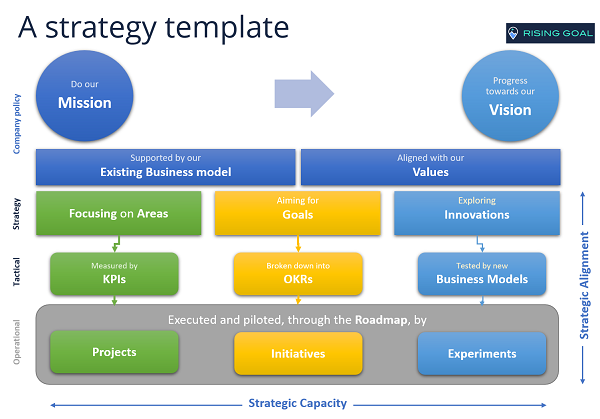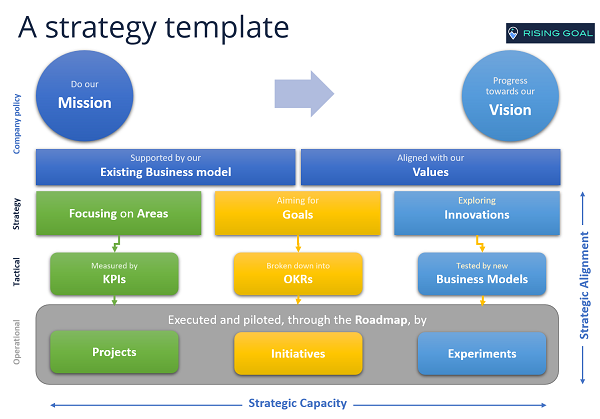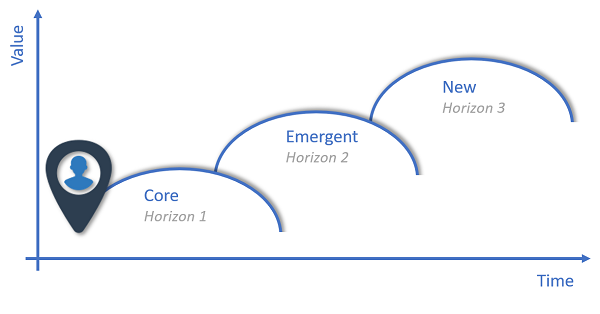A strategy Template
It’s time to strengthen our game in the area of strategy to improve our objectives!
Intro
OKRs and strategy
In our last article, we saw that strategy and OKRs are related. OKRs are part of the execution of the strategy. It is also an iterative strategy validation tactic!
We concluded how important strategy is for good OKRs. So, we might as well improve in this difficult discipline! Because we are not all great strategists!
When we learn about the company strategy, we read about the company’s mission, its vision, its values, focus areas, goals, … I have always been a little confused. So much so that I tried to structure this by making sense of these concepts. This is a strategy template that I suggest you explore.
Google’s example
To illustrate this strategy template, let’s take the example of google which has the advantage of being very well documented.
Mission
To organize the world’s information and make it universally accessible and useful.
>
Vision
To make search engine so powerful they would understand “everything in the world”
Values
You can read this article on the 10 values of google.
Value #1
Privilege the user, the rest will follow
Value #2
Better do one thing and do it right
Value #3
Always faster
Focus Areas
- Innovation
- User Experience
Explore the strategy template
Strategy, the art of identifying what will last
There are two components of the strategy. The first is the identification of what will last. It seems obvious to invest in what will still be present in 5 or 10 years. These are the foundations of the company.
For example, in 5 or 10 years, users will still want to have access to information as quickly as possible. So Google has decided to put “Speed is at the heart of each of our products“.
This is a difficult strategic choice because it means visitors will leave their site faster!
The following concepts fall under this immutable aspect:
Mission
This is the raison d’être, the purpose of the company. That’s what she does and her playground.
Values
They are linked to the fundamentals of the company, the principles that guide it. It is often said that values guide the journey, but ultimately, it’s the journey that counts thanks to values.
Let’s go back to Google and its philosophy of speed. It is so important and unchanging that it has become one of their values.
Focus Area
These are the activities you want to focus on and spend time on. They allow you to consolidate your strengths by developing centers of excellence or areas of expertise. These are your skills allowing you to execute the strategy in addition to a suitable organization and managerial system.
Each of your values should have a few areas of focus. These measurable areas of focus that will secure your values. That is the reason we need values when designing the strategy. Values are not only related to the company’s culture.
Suppose one of your business values is an amazing customer service. The voice of the customer should be a focus area.
This is the case for google whose focus on innovation and user experience.
KPI
To monitor the strategic performance of the focus areas, we need key indicators.
This is exactly the role of KPIs. And this is why I am citing them here. Even the most inspiring areas of focus will have no impact if they cannot be followed.
A Kpi related to customer experience can be tracking customer loyalty, or the number of brand ambassadors.
Project
To keep under control or improve the focus areas, we will identify projects that will feed our roadmap. This is what makes these focus areas alive, up to date, at the state of the art …
Explore the strategy template
Strategy, the art of identifying the main directions of tomorrow
Of course, investing in what is immutable is not enough to be successful. Thus, the strategy also embraces change through the aspirations and major orientations of tomorrow. You must identify and position yourself well, by projecting yourself over a horizon of a few years.
This is the second part of the strategy. This is where the following concepts come in:
Vision
The vision is the desirable long-term (5-10 year) future state. This future is aspirational because it must encourage transformation. And it brings structural change to the business model, organization, skills, …
Moreover, this is the horizon of emerging activities, intrapreneurship. In other words, the vision should enable long-term growth.
Surprisingly, we often confuse mission (today) with vision (tomorrow)!
Goals
Goals are the medium-term strategic project, its strategic priorities for 3 to 5 years. They are expressed in the form of results.
This is what should make the activities of tomorrow emerge. Not only what guides the direction and the big decisions of the organization. But also, the horizon for new high growth activities.
Google is also known for X, the moonshot factory, whose goals are to have 10x impact on the world’s most intractable problems.
OKR
To make these medium-term goals actionable, the ORKs are coming on the scene. The time horizon is shorter, maximum one year for strategic OKRs. OKRs are more specifics than goals. In fact, goals are broken down into tactical, team OKRs, generally quarterly (read more about OKR Cycle).
By the way, it is the counterpart of KPIs & projects, but the version with impact and change!
When Google launched the beta version of Chrome, one of the key results Sundar Pichai set for the end of 2008 is to reach 20 million users! In only one quarter, it’s growth like google …
Initiative
These OKRs translate into concrete initiatives, which feed into the roadmap.
Explore the strategy template
Strategy, the art of exploring the unknown future
Updated 04/28/2022
Goals & OKRs are great when we know where to go. But a company needs to explore and innovate to stay in the race. To complete the model, we have the following concepts:
Innovation
We are not talking about continuous or incremental improvement innovation here. But breakthrough innovation (for the company, possibly for the market). That means working creatively with the unknown, the partially known and the uncertain.
Business model
The impact is to explore, test and validate new business models for the company, in an entrepreneurial approach.
Experiment
Given the degree of uncertainty linked to these innovations, this activity is not managed like traditional projects, but rather like experiments. The goal is to learn as quickly as possible, by validating or invalidating our assumptions.
The roadmap
The roadmap is therefore full of projects, initiatives and experiments. They are all basically projects. But projects focus on evolving existing activities while initiatives focus on change. The latter is in essence more agile. At the extreme, we find the experiments, in the sense of the lean start-up method. While all are projects, they are managed quite differently.
Conclusion
A strategy template
A travel metaphor
Suppose you are driving for a long trip. Your final destination is your vision. The legs of the trip are the goals. Focusing on the road and good driving to avoid an accident are your focus areas. Failure to follow them could lead to accident. They will follow you all the way. Speed is a KPI to follow in relation to good driving. Choosing the route according to the restaurants is a good OKR!
And here is the strategy template as a whole:
Of course, this template is not going to help you come up with the right ideas. This is the role of all strategic tools such as SWOT analysis, strategic canvases, five forces analysis and so on. Those tools especially help you to fill the focus areas and the goals.
But it allows you to better organize and structure your ideas, even to explain and communicate them.
To end with the example of google, we can formulate the strategy as:
Move from the accessibility of information to its universal understanding through innovation and user experience, aiming for goals with 10x impact.
To conclude, this model can be applied to the four levels of strategies: corporate, business, functional and operational.
Finally, the whole process of the strategy to its execution can be visualized by:
Explore the full Rising Goal Model
Our solution has a complete model from strategy to execution, with Strategy, OKR, KPI & initiatives!
Related Posts
OKR Cycle
OKR cycle will allow you to define and organize the life cycle of your OKRs in your organization. Set the medium-term and short-term goals.
OKRs and strategy
Stop confusing OKRs and strategy! OKR Method is part of the strategy execution and serve the company strategy.









Recent Comments